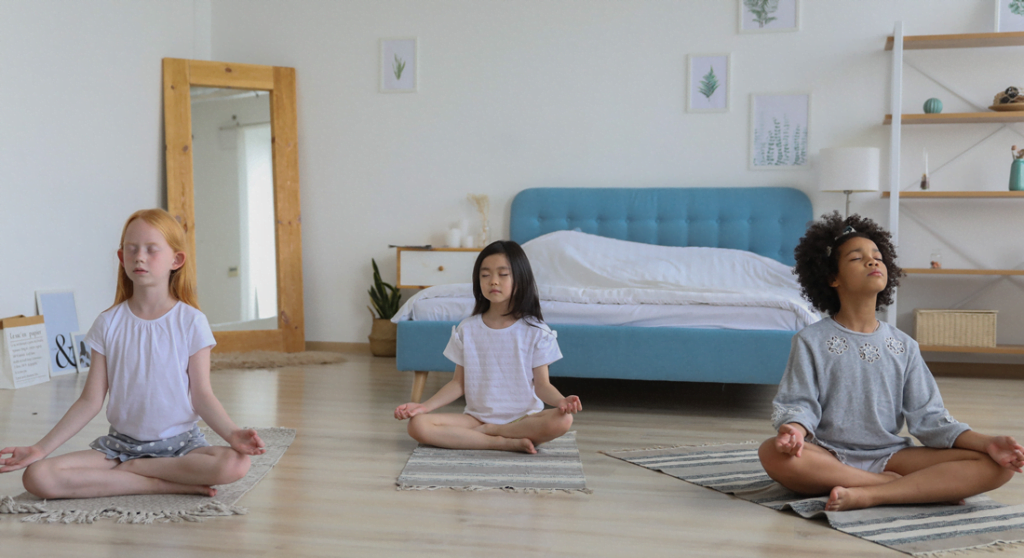In a world that constantly demands our attention and pushes us to the brink of overwhelm, finding moments of tranquility and inner peace has become more crucial than ever. Amid the chaos and noise of modern life, the practice of guided meditation emerges as a soothing balm for our restless minds and weary souls.
In this blog post, we’ll unravel the mysteries surrounding this transformative practice, delving into its essence, benefits, and how it can become an integral part of your daily routine. Guided meditation isn’t just about sitting in silence; it’s an artful blend of relaxation techniques, visualization, and mindfulness that gently leads you into a state of heightened awareness and serenity.
Join us as we navigate through the lush landscapes of the mind, learning to navigate the waves of our thoughts and emotions with grace. From understanding the foundational principles to discovering the various styles and themes that cater to your unique needs, this journey promises to illuminate the path to inner peace and clarity. So, let us embark on this enlightening voyage together, unlocking the transformative power of guided meditation and nurturing a sanctuary of calm within ourselves amidst the bustling world around us.
Understanding Guided Meditation
Guided meditation is a form of meditation in which a trained instructor or a recorded voice provides verbal guidance to lead participants through a specific meditation experience. Unlike traditional meditation, where practitioners often focus on their breath, a mantra, or an object, guided meditation involves following the guidance of the instructor’s words to help create a mental image, evoke sensations, or focus on specific thoughts or emotions.
In guided meditation, the instructor’s soothing voice typically directs participants to relax, let go of stress, and enter a state of deep relaxation. This can involve progressive muscle relaxation, deep breathing exercises, and visualization techniques. The instructor might take participants on a mental journey, describing serene landscapes, peaceful scenarios, or even specific situations designed to promote healing, self-discovery, or personal growth.
Guided meditation can be practiced individually or in a group setting, and it’s often used for various purposes, including stress reduction, anxiety management, emotional healing, personal development, and enhancing overall well-being. It’s particularly appealing to beginners or individuals who find it challenging to maintain focus during traditional meditation, as the guided instructions help anchor their attention.
The recorded guided meditations are widely available through apps, online platforms, meditation websites, and audio recordings. Additionally, guided meditation sessions can be conducted in person by a meditation teacher or practitioner. The practice can be adapted to different themes, styles, and intentions, making it a versatile tool for cultivating mindfulness, relaxation, and inner peace.
Getting Started with Guided Meditation
Getting started with guided meditation can be a rewarding and soothing experience. Here’s a step-by-step guide to help you embark on your journey:
1: Choose a Quiet and Comfortable Space
Find a peaceful and quiet place where you won’t be disturbed. Create a comfortable environment by sitting or lying down on a cushion, mat, or chair. Ensure that your body is in a relaxed posture, and consider using a cozy blanket for added comfort.
2: Select a Guided Meditation Resource
Explore different guided meditation resources to find the one that resonates with you. This could be a meditation app, a website offering guided sessions, or recorded audio tracks. Look for options that align with your intentions, whether it’s stress relief, relaxation, or personal growth.
3: Set Your Intention
Before you start the guided meditation, set a clear intention or purpose for your practice. It could be to reduce stress, enhance focus, cultivate gratitude, or any other goal that resonates with you. Setting an intention helps you stay focused and engaged throughout the session.
4: Get Comfortable and Relax
Once you’ve chosen your guided meditation, press play and close your eyes. Take a few moments to settle into your chosen posture and relax your body. Let go of any tension in your muscles and take a few deep, calming breaths to center yourself.
5: Follow the Instructor’s Guidance
Listen attentively to the instructor’s voice as they guide you through the meditation. They might lead you through relaxation techniques, deep breathing exercises, and visualizations. Allow yourself to immerse in their words and follow their instructions with an open mind.
6: Embrace Visualization
During the meditation, the instructor may guide you through a mental journey or visualization. Create vivid mental images based on their descriptions. Engage your senses – feel the textures, hear the sounds, and imagine the scents of the environment they describe.
7: Cultivate Mindfulness
Stay present and attentive throughout the guided meditation. If your mind starts to wander, gently redirect your focus to the instructor’s voice or the imagery they’re describing. Practice observing your thoughts without judgment and bring your attention back to the meditation whenever you notice distractions.
8: Gradually Transition Back
As the guided meditation comes to an end, the instructor will often guide you back to a state of wakefulness. They might suggest slowly bringing awareness back to your body or gently opening your eyes. Take your time transitioning from the meditative state to your regular awareness.
9: Reflect and Journal
After the guided meditation, take a few moments to reflect on your experience. How do you feel? What insights or sensations did you notice during the practice? Consider jotting down your thoughts and feelings in a meditation journal to track your progress and reflections over time.
10: Make it a Habit
To truly benefit from guided meditation, make it a consistent part of your routine. Set aside a specific time each day or week to practice. Over time, you’ll likely notice the positive effects of regular guided meditation on your overall well-being and inner peace.
The Elements of Guided Meditation
The practice of guided meditation involves several key elements that work together to create a deeply relaxing and introspective experience. These elements are carefully crafted to guide participants into a state of calm, mindfulness, and inner exploration. Let’s discuss the main elements of guided meditation:
1. Relaxation Techniques
At the start of a guided meditation session, relaxation techniques are often used to help participants release physical tension and prepare for the meditation. This can include deep breathing exercises, progressive muscle relaxation, and gentle stretches. By relaxing the body, participants become more receptive to the meditation’s guidance and visualization.
2. Visualization
Visualization is a powerful component of guided meditation. The instructor’s words guide participants to imagine specific images, scenes, or scenarios. This mental imagery helps engage the senses and creates a vivid and immersive experience. Visualization can transport participants to tranquil environments, symbolically address challenges, or stimulate positive emotions.
3. Mindfulness and Awareness
Guided meditation encourages mindfulness, which involves being fully present and aware of the current moment. Participants are guided to observe their thoughts, sensations, and emotions without judgment. The instructor may encourage a gentle return to the present if the mind wanders. This element helps cultivate mindfulness and self-awareness, promoting a deeper connection with one’s inner self.
4. Positive Affirmations and Suggestions
During guided meditation, instructors often incorporate positive affirmations and suggestions. These affirmations aim to promote self-confidence, relaxation, or other desirable states of mind. By repeating these affirmations or suggestions, participants can reshape their thought patterns and foster a more positive mindset.
5. Sensory Engagement
Guided meditation may involve sensory engagement, where participants are prompted to focus on their senses. This could include noticing the sensation of breath, the feeling of relaxation in the body, or even exploring sensory experiences within the guided visualization. Engaging the senses can enhance mindfulness and deepen the meditative experience.
6. Emotional Exploration
Guided meditation can provide a safe space for participants to explore and acknowledge their emotions. The instructor may guide participants to connect with specific emotions, allowing them to process and release any emotional tension. This element encourages emotional intelligence and supports overall well-being.
7. Intentions and Themes
Many guided meditations are centered around specific intentions or themes, such as stress relief, gratitude, self-compassion, or personal growth. These intentions give participants a focus for their practice and can lead to deeper insights and transformations.
8. Breath Awareness
Even within guided meditation, attention to the breath remains a fundamental element. Instructors often guide participants to focus on their breath as an anchor to the present moment. Breath awareness helps calm the mind, reduce distractions, and promote relaxation.
9. Music and Soundscapes
Background music, ambient sounds, or gentle nature sounds are sometimes incorporated into guided meditation sessions. These auditory elements can enhance the meditative experience, evoke specific moods, and deepen relaxation.
10. Closing and Reflection
Towards the end of a guided meditation, participants are often gently guided back to their present awareness. The instructor may encourage reflection on the experience, the emotions felt, or any insights gained during the meditation. This closing phase allows participants to gradually transition from the meditative state back to their everyday consciousness.
Combining these elements in guided meditation creates a holistic experience that supports relaxation, self-awareness, emotional well-being, and personal growth.
Overcoming Common Challenges
Guided meditation, while highly beneficial, can sometimes present challenges, especially for beginners. Here are some common challenges and strategies to overcome them:
1. Restlessness and Impatience
Challenge: It’s common to feel restless or impatient, especially when starting guided meditation.
Solution: Acknowledge these feelings without judgment. Remind yourself that meditation is a skill that takes time to develop. Focus on the present moment and gently guide your attention back to the meditation whenever your mind wanders.
2. Wandering Thoughts
Challenge: The mind can easily wander during guided meditation, leading to distraction.
Solution: Recognize that thoughts are natural and don’t berate yourself for them. When you notice your mind has drifted, gently bring your focus back to the instructor’s guidance or the visualization. Over time, your ability to stay focused will improve.
3. Discomfort or Physical Restlessness
Challenge: Physical discomfort or restlessness can make it challenging to stay still during meditation.
Solution: Find a comfortable sitting or lying position. If discomfort arises, adjust your posture mindfully. You can also try different meditation postures or use cushions and props to support your comfort.
4. Impatience with Results
Challenge: Expecting immediate results or dramatic experiences can lead to frustration.
Solution: Understand that meditation is a gradual process. Set realistic expectations and remind yourself that the benefits of meditation often unfold over time. Focus on the process rather than immediate outcomes.
5. Falling Asleep
Challenge: Guided meditation sessions may sometimes make you feel drowsy or even fall asleep.
Solution: Choose a time of day when you’re naturally more awake and alert. If you’re constantly falling asleep, consider practicing guided meditation in a seated position or trying shorter sessions until you build your ability to stay attentive.
6. Overwhelm with Emotions
Challenge: Guided meditation can sometimes bring up strong emotions that you may find overwhelming.
Solution: If intense emotions arise, remember that meditation can uncover buried feelings. Allow yourself to experience them without judgment. If it becomes too intense, consider talking to a mental health professional for guidance.
7. Finding Consistency
Challenge: Establishing a consistent meditation routine can be challenging amidst a busy schedule.
Solution: Set a specific time for meditation each day and treat it as a non-negotiable appointment with yourself. Start with shorter sessions if needed and gradually increase the duration as your routine becomes more established.
8. Struggling with Visualization
Challenge: Some people find it difficult to vividly visualize during guided meditation.
Solution: Visualization is a skill that improves with practice. Be patient with yourself and don’t worry about getting every detail right. Focus on the overall feeling and atmosphere described by the instructor.
9. Comparing Experiences
Challenge: Comparing your meditation experience to others’ or expecting it to match a certain ideal can lead to frustration.
Solution: Remember that meditation experiences vary from person to person. Your practice is unique to you. Avoid comparing and focus on your own growth and progress.
10. Skipping Sessions
Challenge: Skipping meditation sessions due to lack of motivation or time constraints.
Solution: Remind yourself of the benefits and commit to a manageable schedule. Even a few minutes of guided meditation can be beneficial. Use reminders, set alarms, or integrate meditation into your daily routine to stay consistent.
Overcoming these challenges requires patience, self-compassion, and a willingness to learn from each meditation experience. Remember that guided meditation is a journey, and the challenges you encounter can ultimately contribute to your growth and development.
Closing Thoughts
In a world that often rushes past us, leaving us stressed and overwhelmed, guided meditation stands as a steadfast companion on our journey towards inner peace and self-discovery. Through this transformative practice, we have delved into the realms of relaxation, mindfulness, and emotional exploration, guided by the soothing voices that gently led us within.
As we conclude this exploration of guided meditation, let us remember that the true essence of this practice lies not only in the words spoken or the images conjured but in the moments of stillness and presence we gift ourselves. Guided meditation offers a sanctuary amidst the chaos, a sanctuary that requires no more than your willingness to embark on a voyage of self-care and self-awareness.
May you continue to nurture this newfound connection with yourself, drawing from the wellspring of tranquility that guided meditation provides. Let its gentle guidance carry you through the ebbs and flows of life, helping you navigate challenges with a renewed sense of clarity and calm.








